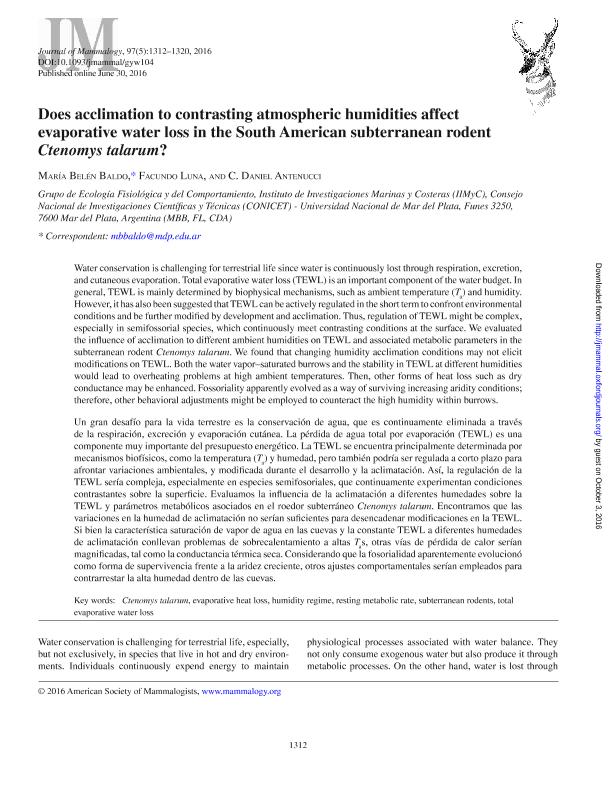Artículo
Does acclimation to contrasting atmospheric humidities affect evaporative water loss in the South American subterranean rodent Ctenomys talarum?
Fecha de publicación:
27/09/2016
Editorial:
Alliance Communications Group Division Allen Press
Revista:
Journal of Mammalogy
ISSN:
0022-2372
e-ISSN:
1545-1542
Idioma:
Inglés
Tipo de recurso:
Artículo publicado
Clasificación temática:
Resumen
Water conservation is challenging for terrestrial life since water is continuously lost through respiration, excretion, and cutaneous evaporation. Total evaporative water loss (TEWL) is an important component of the water budget. In general, TEWL is mainly determined by biophysical mechanisms, such as ambient temperature (T a) and humidity. However, it has also been suggested that TEWL can be actively regulated in the short term to confront environmental conditions and be further modified by development and acclimation. Thus, regulation of TEWL might be complex, especially in semifossorial species, which continuously meet contrasting conditions at the surface. We evaluated the influence of acclimation to different ambient humidities on TEWL and associated metabolic parameters in the subterranean rodent Ctenomys talarum. We found that changing humidity acclimation conditions may not elicit modifications on TEWL. Both the water vapor-saturated burrows and the stability in TEWL at different humidities would lead to overheating problems at high ambient temperatures. Then, other forms of heat loss such as dry conductance may be enhanced. Fossoriality apparently evolved as a way of surviving increasing aridity conditions; therefore, other behavioral adjustments might be employed to counteract the high humidity within burrows.
Archivos asociados
Licencia
Identificadores
Colecciones
Articulos(IIMYC)
Articulos de INSTITUTO DE INVESTIGACIONES MARINAS Y COSTERAS
Articulos de INSTITUTO DE INVESTIGACIONES MARINAS Y COSTERAS
Citación
Baldo, María Belén; Luna, Facundo; Antenucci, Carlos Daniel; Does acclimation to contrasting atmospheric humidities affect evaporative water loss in the South American subterranean rodent Ctenomys talarum?; Alliance Communications Group Division Allen Press; Journal of Mammalogy; 97; 5; 27-9-2016; 1312-1320
Compartir
Altmétricas




